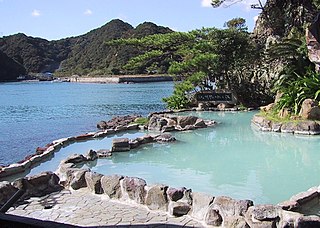
In Japan, onsen are hot springs and the bathing facilities and traditional inns around them. There are approximately 25,000 hot spring sources throughout Japan, and approximately 3,000 onsen establishments use naturally hot water from these geothermally heated springs.

The West Lake is a freshwater lake in Hangzhou, China. Situated to the west of Hangzhou's former walled city, the lake has a surface area of 6.39 km2 (2.47 sq mi), stretching 3.2 km (2.0 mi) from north to south and 2.8 km (1.7 mi) from east to west. In the lake are four causeways, three artificial islands, and the Gushan, the only natural island. Gentle hills surround the lake on its north, west, and south sides, with the Leifeng and Baochu pagodas standing in pair on the south and north banks. Several famous temples are nestled in the mountains west of the lake, including the temples of Lingying and Jingci.

Totsukawa is a geographically large village in the Yoshino District of Nara, Japan. It is the largest village in Nara in terms of area, and the fifth largest village in Japan. As of February 2024, the village has an estimated population of 2,845 and a density of 4.2 persons per km2. The total area is 672.35 km2 (259.60 sq mi).

Hot Shot is a Taiwanese drama starring Jerry Yan of F4, Show Lo, and Wu Chun of Fahrenheit. It was produced by Comic International Productions and directed by Lin He Long.

Nagoya University, abbreviated to Meidai (名大) or NU, is a Japanese national research university located in Chikusa-ku, Nagoya.

The Yaeyama Islands are an archipelago in the southwest of Okinawa Prefecture, Japan, and cover 591.46 square kilometres (228.36 sq mi). The islands are located southwest of the Miyako Islands, part of the Ryukyu Islands archipelago. The Yaeyama Islands are the remotest part of Japan from the main islands and contain Japan's most southern (Hateruma) and most western (Yonaguni) inhabited islands. The city of Ishigaki serves as the political, cultural, and economic center of the Yaeyama Islands. On maps dating to the 1700s, the Yaeyama Group of Islands appears as the "Majico Sima Group", "Nambu-soto Islands", "Nambu Soto", and the "Taipin Islands".
Feel, Inc. is a Japanese animation studio founded in 2002. The studio is a subsidiary of Fun-Media, a Holdings company, who also owns animation studios Assez Finaud Fabric and Zexcs, which are also located in the same building as Feel.

Ōzukumi-jima (大築海島) is an island located in Ise Bay off the east coast of central Honshu, Japan. It is administered as part of the city of Toba in Mie Prefecture.

The Miss Nippon Contest is a Japanese beauty pageant. In the past 57 competitions, the total number of applications is 118,794 people and the Grand Prix is 55 people. It started in 1950 by the Yomiuri Shimbun and is held every year by the "Miss Nippon Association".

Tatsuo Nishida was a professor at Kyoto University. His work encompasses research on a variety of Tibeto-Burman languages, he made great contributions in particular to the deciphering of the Tangut language.
Joyful Train is the name given to railway rolling stock or train sets operated by the JR Group in Japan primarily for charters, special events, tourist excursions, and other similar purposes. Traditionally, this term is only used for chartered trains dedicated to large group travel, but in recent years, it has expanded to include sightseeing trains and tourist trains as well, as their distinctions are made ambiguous. This page includes all trains considered "Joyful trains" and "Sightseeing trains".

Hitsumabushi is a local dish of Japan, consisting of thinly sliced unagi (eel) grilled in kabayaki style on rice. Hitsumabushi became common in the 1950s, when farm-raised eel became widely available.

The Japanese sandfish, also known as the sailfin sandfish, is a species of fish of the Percomorpha (perch-like) clade in the order Trachiniformes, being one of the two genera in the family Trichodontidae, the sandfishes. Known in Japan as hatahata, it is a commercially important fish especially for Akita and Yamagata prefectures. Its habitat occurs in sandy-mud bottoms ranging from the Sea of Japan to the Okhotsk Sea.

Cao Cao is a Chinese television series based on the life of Cao Cao, a warlord who rose to power towards the end of the Eastern Han dynasty and laid the foundation for the state of Cao Wei in the Three Kingdoms period. Directed by Hu Mei, the series aimed to portray a more historically accurate image of Cao Cao, who is traditionally depicted as a villain in Chinese culture. Starring Zhao Lixin as the eponymous character, the series was filmed at the Xiangshan Film City in Ningbo, Zhejiang between 1 November 2011 and 15 March 2012.

Thunderbolt Fantasy, also known as Thunderbolt Fantasy: Sword Seekers, is a Japanese-Taiwanese glove puppetry television series created and written by Gen Urobuchi and produced as a collaboration between Japanese companies Nitroplus and Good Smile Company and Taiwanese puppet production company Pili International Multimedia, creators of Pili ("Thunderbolt") series. The series began airing in Japan on July 8, 2016 and is being simulcast by Bahamut and iQiyi Taiwan in Taiwan, bilibili in Mainland China, and Crunchyroll in the United States. It has two official languages: the Taiwanese Min-Nan version aired in Taiwan, and the Japanese version aired outside Taiwan. A manga adaptation illustrated by Yui Sakuma was serialized in Kodansha's Weekly Morning magazine from July 21, 2016 to April 6, 2017. A second adaption, told from the perspective of Dān Fěi, and illustrated by Kairi Shimotsuki, was serialized in Akita Shoten's Champion Cross online magazine from September 27, 2016 to February 28, 2017. A side novel that focuses on the pasts of Lǐn Xuě Yā, Xíng Hài, and Shā Wú Shēng was released on April 7, 2017, and was partially adapted into a film released that year on December 2. A second season aired in 2018, while a film prequel to it was released on October 25, 2019. A third season aired in 2021. A fourth season will air in 2024, with a series finale film releasing in 2025.

Douluo Continent is a 2021 Chinese television series based on a fantasy novel of the same name by Tang Jia San Shao, starring Xiao Zhan and Wu Xuanyi. It premiered on Tencent Video, CCTV and WeTV on February 5. It was successful despite its data suppression.
A school meal is a meal provided to students and sometimes teachers at a school, typically in the middle or beginning of the school day. In Japan, this usually refers to school meals served as lunch. The origin of school meals provided in Japan is in 1889, where an elementary school provided free meals for children who could not bring food to school. Post–World War II school meals usually had a loaf of bread and skimmed milk, although rice returned to school meals in 1976.















